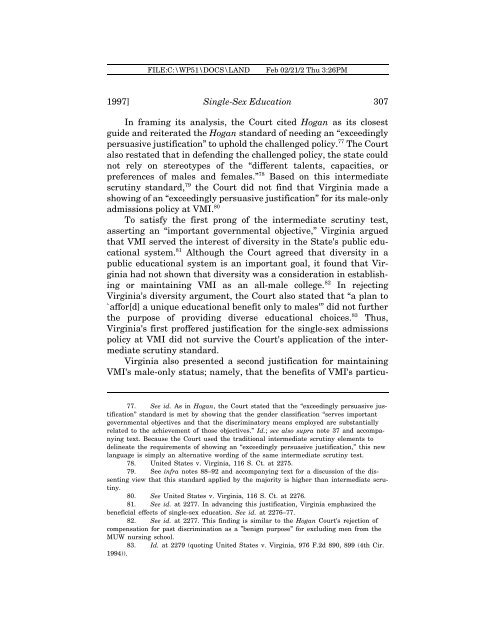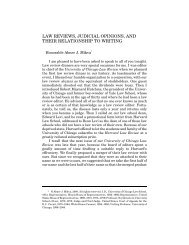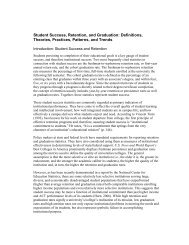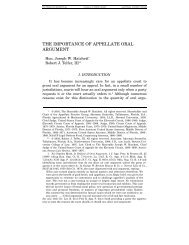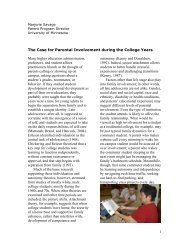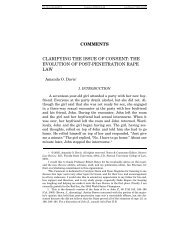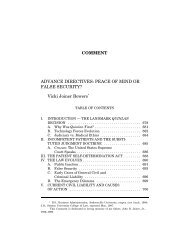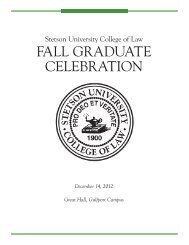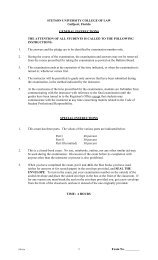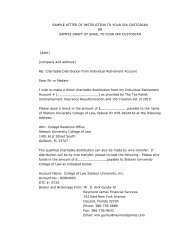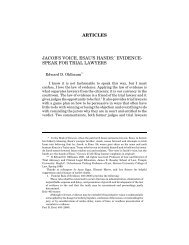The Future of Single-Sex Education After United ... - Stetson University
The Future of Single-Sex Education After United ... - Stetson University
The Future of Single-Sex Education After United ... - Stetson University
Create successful ePaper yourself
Turn your PDF publications into a flip-book with our unique Google optimized e-Paper software.
FILE:C:\WP51\DOCS\LANDFeb 02/21/2 Thu 3:26PM1997] <strong>Single</strong>-<strong>Sex</strong> <strong>Education</strong> 307In framing its analysis, the Court cited Hogan as its closestguide and reiterated the Hogan standard <strong>of</strong> needing an “exceedinglypersuasive justification” to uphold the challenged policy. 77 <strong>The</strong> Courtalso restated that in defending the challenged policy, the state couldnot rely on stereotypes <strong>of</strong> the “different talents, capacities, orpreferences <strong>of</strong> males and females.” 78 Based on this intermediatescrutiny standard, 79 the Court did not find that Virginia made ashowing <strong>of</strong> an “exceedingly persuasive justification” for its male-onlyadmissions policy at VMI. 80To satisfy the first prong <strong>of</strong> the intermediate scrutiny test,asserting an “important governmental objective,” Virginia arguedthat VMI served the interest <strong>of</strong> diversity in the State's public educationalsystem. 81 Although the Court agreed that diversity in apublic educational system is an important goal, it found that Virginiahad not shown that diversity was a consideration in establishingor maintaining VMI as an all-male college. 82 In rejectingVirginia's diversity argument, the Court also stated that “a plan to`affor[d] a unique educational benefit only to males'” did not furtherthe purpose <strong>of</strong> providing diverse educational choices. 83 Thus,Virginia's first pr<strong>of</strong>fered justification for the single-sex admissionspolicy at VMI did not survive the Court's application <strong>of</strong> the intermediatescrutiny standard.Virginia also presented a second justification for maintainingVMI's male-only status; namely, that the benefits <strong>of</strong> VMI's particu-77. See id. As in Hogan, the Court stated that the “exceedingly persuasive justification”standard is met by showing that the gender classification “serves importantgovernmental objectives and that the discriminatory means employed are substantiallyrelated to the achievement <strong>of</strong> those objectives.” Id.; see also supra note 37 and accompanyingtext. Because the Court used the traditional intermediate scrutiny elements todelineate the requirements <strong>of</strong> showing an “exceedingly persuasive justification,” this newlanguage is simply an alternative wording <strong>of</strong> the same intermediate scrutiny test.78. <strong>United</strong> States v. Virginia, 116 S. Ct. at 2275.79. See infra notes 88–92 and accompanying text for a discussion <strong>of</strong> the dissentingview that this standard applied by the majority is higher than intermediate scrutiny.80. See <strong>United</strong> States v. Virginia, 116 S. Ct. at 2276.81. See id. at 2277. In advancing this justification, Virginia emphasized thebeneficial effects <strong>of</strong> single-sex education. See id. at 2276–77.82. See id. at 2277. This finding is similar to the Hogan Court's rejection <strong>of</strong>compensation for past discrimination as a ”benign purpose” for excluding men from theMUW nursing school.83. Id. at 2279 (quoting <strong>United</strong> States v. Virginia, 976 F.2d 890, 899 (4th Cir.1994)).


